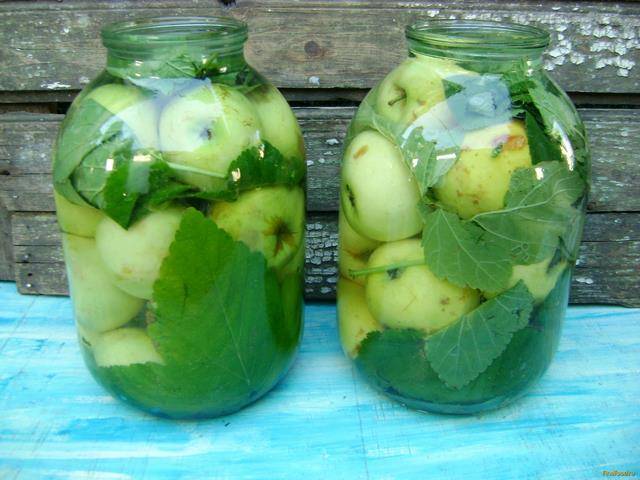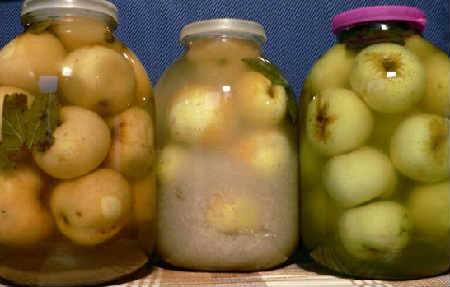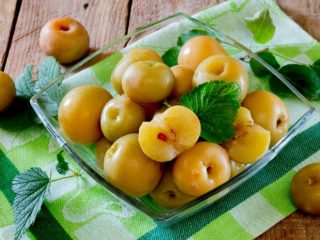Content
Pickled apples are a traditional Russian product. Our ancestors knew well how to preserve this healthy fruit until spring. There are many old recipes for pickling apples with various, and sometimes very unexpected, additives. Most of these recipes are designed for large barrels. Made in a container like this sauerkraut with apples, and soaked them using rye straw. In the old days, families were large, and there was also a place to store such preparations. Nowadays, urban residents are the overwhelming majority; a basement in the city is a rarity. Therefore, housewives prefer to cook soaked apples in small containers, for example, in 3-liter jars.
What are the benefits of soaked apples?
Apples, both fresh and prepared, are a healthy and necessary product for humans. To maintain a healthy intestine, they need to be consumed daily. Urine is a type of fermentation, and many people know about the benefits of fermented products. The resulting lactic acid normalizes intestinal function, thereby stimulating the immune system. Therefore, such a product should be in every home.
What is the process of urination?
Urination happens:
- sweet, while in addition to salt, sugar is also added to the brine;
- sour, according to this ancient method, rye flour prepared in a special way is involved in the soaking;
- salty, no sugar is added; only sugars contained in the fruits themselves participate in the process of lactic fermentation.
But no matter which method of urination you choose, the fruits need to be properly selected and prepared.
Selection and preparation of apples
In the old days there were not so many varieties of apples. Late varieties were always chosen for soaking; the old and proven Antonovka variety is considered the best.
So it’s better to just eat delicious summer apples or leave them for jam, however, there is a recipe for pickled apples of these varieties.
The fruits must be ripe without damage or rot, so it is better to remove them from the tree rather than pick up the carrion. But do not rush to wet freshly picked fruits. They need to rest for a couple of weeks.
The size of the fruit is also important. Large apples do not fit well in a container for soaking; they take longer to soak in brine, so the fermentation process is delayed. Very small ones are also not suitable, but a medium size is just right.
Cooking recipes
Let's prepare soaked apples in jars using old recipes.
Apples soaked with rye flour
For a 3-liter jar you will need:
- apples - 2 kg;
- rye flour - 30 g;
- salt - 1/3 tbsp. spoons;
- water - 1.5 l.
Preparing sourdough. To do this, pour boiling water over rye flour mixed with salt.The most difficult thing at this stage is to achieve a homogeneous mixture.
Strain the settled and cooled starter using cheesecloth. Place washed and dried apples in clean jars. Fill with sourdough. Turn the plastic lid over and insert it into the jar, bending it slightly. We put pressure on her.
A small jar or bottle of water is suitable as oppression.
Fruits absorb the filling very well. If it no longer covers them, you will have to prepare additional starter. The fermentation process will last at least one and a half months. The place should be cool: balcony, basement or refrigerator. When it is finished, remove the oppression and store the workpiece in the cold under a regular plastic cover.
Apples soaked with mint, cherry, currant leaves
For 3 cans of 3 liters you need:
- 5 liters of water;
- a glass of sugar;
- 1 tbsp. a heaped spoonful of salt;
- apples - how many will go in depends on the size;
- leaves of mint, lemon balm, oregano, currant and cherry.
Place several leaves of cherries, mint, and currants in sterilized jars. Lay the apples and cover each layer with leaves. Leaves should also be on top.
Prepare the filling: boil water with sugar and salt for 5 minutes, cool. We pour the fruit so that the filling completely covers them, put the rest of the filling in the refrigerator, we will add it to the jars as it is absorbed into the apples. The fermentation process takes place at a temperature of no more than 22 degrees.
During fermentation, foam forms; it must be skimmed off.It contains harmful microorganisms that can spoil the product. The recipe does not require pressure, but it is necessary to monitor the level of wort in the jar and add it as needed. The fruit should be covered with it.
When fermentation is over, take the jars out into the cold. The best temperature for preserving soaked apples in jars is no higher than 6 degrees Celsius.
Apples soaked with basil and honey
Another simple recipe for preparing soaked apples in jars for the winter. Instead of sugar, we will use honey; currant leaves and basil sprigs will add an original taste, and the sourdough will have to be made with rye flour.
Ingredients for 10 three-liter jars:
- 20 kg of winter apples;
- 100 g basil sprigs;
- 20 pcs. currant leaves;
- 0.5 kg of honey;
- 170 g coarse salt;
- water - 10 liters, better than spring water;
- 150 g rye flour.
Boil water and cool to 40 degrees, stir honey, salt and flour into it, rub the lumps thoroughly. Allow the wort to cool to room temperature.
Greens and utensils for pickling are washed well. Divide the currant leaves into 2 parts. One should be placed on the bottom of the jars, distributed evenly. Next, lay out the apples, layering them with basil. Place the remaining currant leaves on top, pour in the prepared wort and set the pressure. The apples will ferment for about 2 weeks, the best temperature for this is about 15 degrees Celsius. The finished product is stored in the cold.
Soaked apples with viburnum juice
Apples will be very tasty if you ferment them according to the following recipe. The resulting brine has healing properties. Ingredients for 10 cans:
- 20 kg apples;
- 8 liters of water;
- 2 liters of freshly squeezed viburnum juice;
- 1 kg sugar;
- 50 g coarse salt.
They wash the dishes and apples. Salt and sugar are stirred in boiling water, cooled, and mixed with juice squeezed from viburnum berries. To do this, you need to sort it out, wash it and rub it through a sieve. Apples placed in jars are poured with prepared wort, pressure is set and sent for fermentation. The product is ready in a month and a half. Store in a cool place.
Soaked White pouring
Winter apple varieties are the best for soaking, but there is an exception. A tasty product is obtained from apples of the White filling variety.
Ingredients for 2 3L jars:
- apples - 3 kg;
- salt - 3 tbsp. spoons without top;
- sugar - 6 tbsp. spoon without top;
- 9% vinegar - 9 tbsp. spoon;
- 3 leaves of horseradish;
- 12 cherry leaves;
- 6 buds of cloves.
Apples of this variety are too sweet to soak them in the usual way, so we will pickle them. The taste of such fruits is close to pickled ones.
We sterilize the jars, place the spices, distributing them evenly among the jars. Place the washed fruits and pour boiling water over them. Cover the jars with lids for 10 minutes. Drain the water, bring to a boil and pour it into the jars again. Drain the last time, add vinegar, sugar, salt. Boil the marinade, pour it into jars, roll it up, turn it over and let it cool under a blanket.
Conclusion
Regular consumption of soaked apples will improve intestinal function, strengthen the immune system, and enrich the body with vitamins and minerals.


















Good afternoon, Nikolay! The composition and purpose of currant and grape leaves vary greatly. And although the benefits of both are undeniable, currant leaves are placed in marinades to give them a specific aroma. Moreover, thanks to the currant leaf, cucumbers and apples retain their original density without softening during the fermentation process. After all, crunchiness is the main indicator of proper salting of the product. Currant leaves have bactericidal properties.
Grapes cannot boast of such a property. The grape leaf has a large number of useful and nutritious substances. It is often used in cooking and can often be found in traditional medicine recipes. The leaves are subjected to heat treatment (for preparing second courses), pickled or frozen. But it is not used as a component for fermentation and pickling. It will not give apples such a refined aroma and firmness as currants.
There is one thing... it’s unlikely that there would be such a huge number of different recipes now if it weren’t for people’s love of experimenting and searching for new flavors. Thanks to such bold innovations, new dishes appear. Try it, maybe you will become the author of a new recipe for delicious, pickled apples.
Good afternoon. Can I use grape leaf instead of currant leaf?